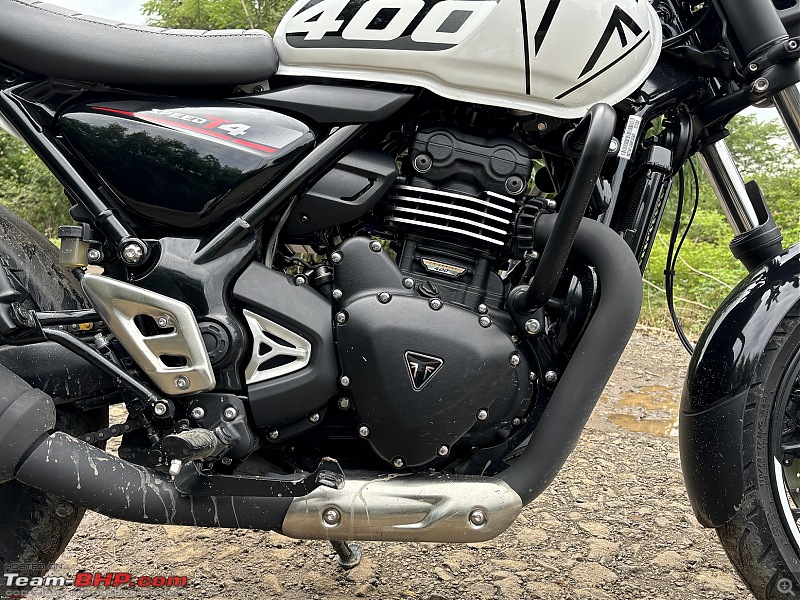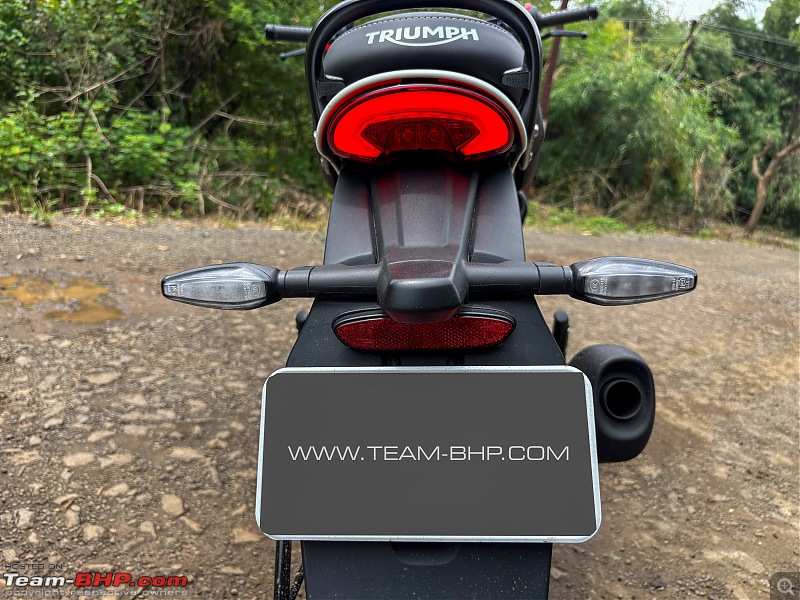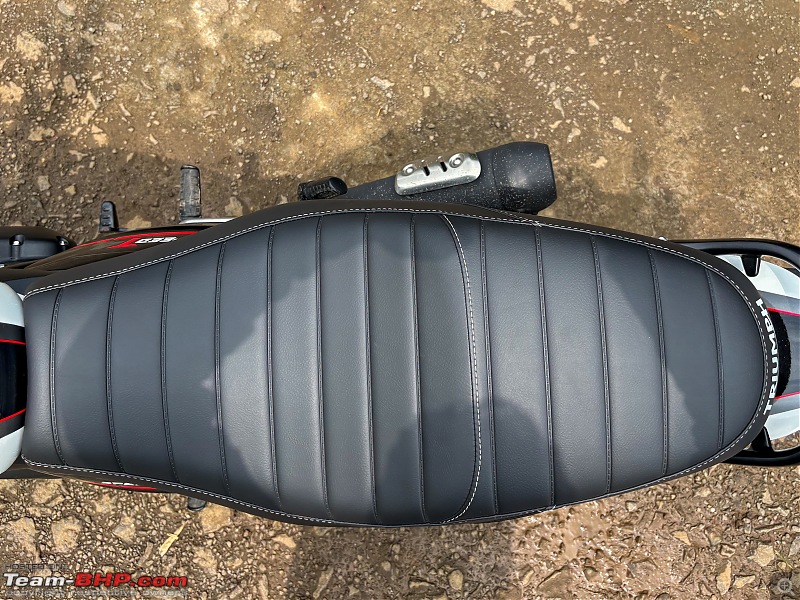Riding the Triumph Speed T4

The characteristic of the engine is the biggest differentiator between the Speed T4 and the standard Speed 400. It is the exact same 398cc, liquid-cooled, single-cylinder unit as the Speed 400 but comes in a lower state of tune putting out 31 BHP @ 7,000 rpm and 36 Nm @ 5,000 rpm (40 BHP @ 8,000 rpm and 37.5 Nm @ 6,500 rpm in the Speed 400). While a deficit of 9 BHP might seem like a lot on paper, keen-eye observers would notice that both power and torque, come significantly earlier compared to its counterpart, making them a lot more useable. In fact, according to Triumph, 85% of torque comes in from as low as 2,500 rpm. This has been achieved by adding 31% more inertia in the crankshaft assembly compared to the Speed 400. Combined with the taller gearing (it gets a smaller 39 teeth sprocket at the rear), makes it a very tractable motorcycle. Even with a pillion, I hardly felt the need to shift down into the first gear or even second gear at times while crossing an average-sized speed-breaker. The presence of a manual throttle body means that you do feel slight jerks on closing the throttle at low speeds in lower gears.
Out on the highway, the engine feels relaxed with hardly any noticeable vibrations at cruising speeds between 80-90 km/h with the rpm meter resting somewhere around the 5,000 mark (hard to gauge in the tiny digital rev meter). I preferred not to cruise faster than this for a prolonged period owing to the significant wind blast. Also, minor vibrations can be felt through the footpegs post 100 km/h. The taller gearing comes in handy here too as the engine easily pulls ahead from 50-55 km/h in sixth gear. When required though, you won’t have anything to complain about the gear-shift quality as it feels slick and quick to operate thanks to the light slipper-clutch. Triumph has also tweaked the exhaust system. As a result, it sounds more bassy compared to the Speed 400 and offers a good amount of thump (especially at idle).
Speaking of heat management, both libranof1987 and I noticed the radiator fan turning on frequently, despite a fairly overcast day in Pune. That being said, the heat emitted from the engine never felt excessive enough to make me uncomfortable. We'll have to wait for ownership reviews to see the effect on the fuel economy due to all the changes.
Refinement & NVH
Another upside to the engine working at lower revs is that it feels a lot more refined and smoother on the Speed T4 compared to the standard Speed 400. The vibrations have been kept in check for most parts and it is only when you rev above 6,000 rpm that you start feeling slight vibes through the footpegs.
Ergonomics and comfort

There are a couple of changes in the ergonomics department. First, the ground clearance has gone up to 170 mm on the Speed T4 from 158 mm on the previous version of the Speed 400 (MY25 Speed 400 gets 164 mm ground clearance). Second, the seat height too has gone up to 805 mm (from 790 mm). While this shouldn’t really be a problem for taller riders, Triumph has reprofiled the front section of the seat and made it slimmer to help shorter riders easily rest their feet down. The seat itself offers good cushioning (neither too soft nor too hard) for both city and highway rides. The width of the fuel tank also feels perfect to grab on to.
Suspension and Handling
Apart from using conventional telescopic forks, Triumph has also revised the steering geometry on the Speed T4. As a result, the wheelbase now stands at 1,406 mm (20 mm longer than the Speed 400). The effect of this in the real world is a slightly lazy front end. That being said, the motorcycle still feels nimble enough to make quick direction changes in city traffic and the longer wheelbase helps in straight line stability.
The rear continues to get a monoshock, albeit with 10 mm less travel. Overall, the suspension setup delivers excellent ride quality. Sitting behind libranof1987 while riding on a broken piece of tarmac, I hardly felt any bumps make their way up my spine, except for a couple of really sharp ones. This is further helped by the extra padding for the pillion seat. On smooth tarmac, the Speed T4 feels stable and I never felt the motorcycle losing its composure at any point. We didn’t try any hardcore cornering but I feel the Speed T4 will easily manage most corners unless you decide to channel your inner MotoGP rider and push it outside its comfort zone.
Braking
Braking duties on the Speed T4 are handled by 300 mm front and 230 mm rear disc brakes. The difference here (compared to the Speed 400) is that it gets axially mounted brake callipers and organic brake pads. While the stopping power is sufficient, the front brake lever does lack feel and bite. The dual-channel ABS works as intended and I never found it to be too intrusive.
Closing Thoughts
To sum up, the Speed T4 is a very well-rounded product. It retains all the positives of the Speed 400, especially the premium build while offering a very different riding experience at a more affordable price tag. But for Rs. 23,000 more, the updated Speed 400 offers a lot more kit, bling and power, making it seem a better value for money proposition. So, why should you buy the Speed T4?
As ironic as it may sound, the Speed T4 is not for someone looking for speed and power. It is for someone who likes to ride in a relaxed manner and the Speed T4 manages to do that quite well. The Hero Mavrick 440 (priced between Rs. 1.99 - 2.24 lakh, ex-showroom) and its American sibling, the Harley-Davidson X440 (priced between Rs. 2.40 - 2.80 lakh, ex-showroom), are two motorcycles in this segment that offer a similar riding experience, but the Triumph manages to one up them in terms of power and build quality. The Speed T4 also manages to outclass the Royal Enfield Hunter 350 in the aforementioned characteristics and more, but the latter is significantly more affordable at Rs. 1.75 lakh, ex-showroom, so that is something to keep in mind. All said and done, both the Speed T4 and Speed 400 are two well-rounded products and no matter what you choose, you won't be left wanting for more.
 (23)
Thanks
(23)
Thanks
 (21)
Thanks
(21)
Thanks
 (30)
Thanks
(30)
Thanks

 (3)
Thanks
(3)
Thanks
 (2)
Thanks
(2)
Thanks
 (3)
Thanks
(3)
Thanks
 (3)
Thanks
(3)
Thanks
 (1)
Thanks
(1)
Thanks
 (1)
Thanks
(1)
Thanks
 (2)
Thanks
(2)
Thanks
 (1)
Thanks
(1)
Thanks
 (1)
Thanks
(1)
Thanks






























